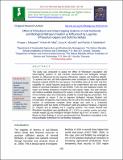| dc.contributor.author | Massawe, Prosper | |
| dc.contributor.author | Mtei, Kelvin | |
| dc.contributor.author | Munishi, Linus | |
| dc.contributor.author | Ndakidemi, Patrick | |
| dc.date.accessioned | 2019-05-21T06:17:06Z | |
| dc.date.available | 2019-05-21T06:17:06Z | |
| dc.date.issued | 2016-10-10 | |
| dc.identifier.issn | 2319-7706 | |
| dc.identifier.uri | http://dx.doi.org/10.20546/ijcmas.2016.510.016 | |
| dc.identifier.uri | http://dspace.nm-aist.ac.tz/handle/123456789/100 | |
| dc.description | Research Article published by International Journal of Current Microbiology and Applied Sciences Volume 5 Number 10 (2016) | en_US |
| dc.description.abstract | The study was conducted to assess the effect of Rhizobium inoculation and
intercropping systems on soil nutrients improvement and biological nitrogen
fixation as influenced by two legumes (Phaseolus vulgaris and Dolichos lablab).
To achieve this aim, the field experiments were conducted at Selian Agricultural
Research Institute (SARI) for two seasons. The fertility status of the soils and their
suitability for cereal/ legumes production at the experimental site was evaluated
based on technical indicators of soil fertility. From the soil analytical results, the
major soil fertility limitations included low soil organic matter, low total nitrogen
and medium available phosphorus for season 1 hence the soils were categorized as
of low fertility status and moderately suitable for cereal/ legumes production. This
was opposite in season 2 due to legumes biological nitrogen fixation and
incorporation of legumes crop residues into the soil as the results of the first season
harvest. A randomized complete block design was used in a 3-factorial
arrangement with two levels of Rhizobium (with and without rhizobia), 2 legumes
(P. vulgaris and D. lablab) and 5 cropping systems. The results showed that
Rhizobium inoculation was significantly (P ≤ 0.001) on nodules number per plant;
nodules weight (g) and biological nitrogen fixation (kg N ha-1) in season 1 and 2.
Based on these findings, it is thus recommended that, Rhizobium inoculation is the
most profitable biofertilizer for soil fertility restoration. | en_US |
| dc.language.iso | en_US | en_US |
| dc.publisher | International Journal of Current Microbiology and Applied Sciences | en_US |
| dc.rights | Attribution-NonCommercial-ShareAlike 4.0 International | * |
| dc.rights.uri | http://creativecommons.org/licenses/by-nc-sa/4.0/ | * |
| dc.subject | Biological nitrogen fixation | en_US |
| dc.subject | Soil nutrients | en_US |
| dc.subject | Intercropping systems | en_US |
| dc.title | Effect of Rhizobium and Intercropping Systems on Soil Nutrients and Biological Nitrogen Fixation as Influenced by Legumes (Phaseolus vulgaris and Dolichos lablab) | en_US |
| dc.type | Article | en_US |


